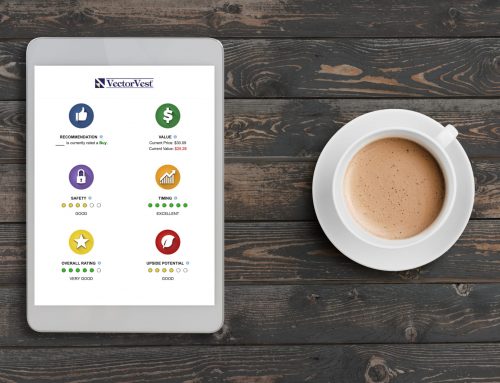Chances are, you’re familiar with the old adage that successful investing is as simple as “buy low, sell high”. This principle forms the cornerstone of a strategy known as bottom fishing stocks, where the focus is to buy stocks at their lowest valley with an anticipation of selling them when they crest.
But should you buy stocks when they are down? After all, you don’t really know with 100% certainty if a stock has reached its lowest point. How can you be sure that a stock is going to rebound rather than sink further?
You’ve come to the right place. At VectorVest, we’ve helped countless investors perfect the principles of bottom fishing for stocks, and we’re excited to help you do the same.
This investment strategy requires precise timing, careful selection, and a deep understanding of the dynamics of the market. But with this in-depth resource and our intuitive suite of tools, you can feel confident and capable of implementing these principles in your own strategy.
The intention isn’t to encourage you to grasp at every falling knife in the stock market, but to provide you with a well-equipped toolbox that allows you to identify when that knife has hit the ground and is ready to be safely picked up. So, let’s start by talking about what we mean when we talk about stocks being “down”.
What Do We Mean When We Talk About Stocks Being “Down”? Introducing the Concept of Bottom Fishing Stocks
In the complex landscape of investing, certain terms have become ubiquitous. From “buy the dip” to “market timing strategy” – there’s a lot to keep up with.
One such term, you’ll often hear, is a stock being “down”. But what does it truly signify? Simply put, when we refer to a stock as being “down”, we mean that its current price is significantly lower than its previous highs.
The reasons for this downward trajectory can be multifaceted – ranging from disappointing earnings reports, change in market sentiment, a recession or economic downturn, to company-specific problems. Investors often view these declines as buying opportunities, assuming the stock price will rebound. This practice is referred to as ‘bottom fishing’.
Bottom fishing stocks is a strategy predicated on the notion of buying assets that have suffered substantial declines and are considered undervalued, potentially offering high returns once they rebound.
The term itself comes from the idea of fishing for opportunities at the ‘bottom’ of the price list. Investors who engage in bottom fishing are fundamentally betting on the theory that the market overreacted to bad news, pushing the stock price down more than it should have, creating an opportunity to buy a good stock at a discount.
As we delve further into this topic, we’ll unpack how to avoid the common pitfalls of this strategy, identify signals for potential rebounds, and understand how to leverage tools such as VectorVest to make more informed investment decisions. That being said, let’s find out if this strategy is even right for you…should you buy stocks when they are down?
Should You Buy Stocks When They Are Down?
The fundamental question of buying stocks when they are down or ‘bottom fishing’ is one that invites contemplation. After all, the stock market is a sea of opportunities and risks that coexist. While buying low and selling high is an easy concept to understand, implementing it effectively requires a careful evaluation of both the upside and downside. Let’s delve into these aspects.
Risks of Buying Stocks When They’re Down
Every investment carries a certain level of risk, and buying stocks when they are down is no exception. The first and most apparent risk is the continuation of a downward trend.
While we may anticipate a rebound, there is always the possibility that a stock may continue to fall. Market conditions, corporate mismanagement, or unfavorable shifts in industry trends can cause a stock’s price to drop further, which could lead to significant losses.
Another risk lies in the difficulty of identifying ‘value traps’. A value trap is a stock that appears to be cheap because it’s trading at low multiples (like P/E ratio), but the company’s actual financial health is deteriorating. These stocks may seem like they’ve hit the bottom and can only go up, but the reality is that they could still have further to fall.
The Upside of Buying Stocks When They’re Down
While the risks are apparent, so are the potential rewards. One of the primary benefits of buying stocks when they’re down is the possibility of purchasing quality stocks at a discounted price.
When market volatility causes widespread selling, fundamentally strong companies often get caught in the crossfire. This scenario presents an opportunity to buy stocks of these companies at lower prices than their intrinsic value, setting the stage for potential profits when the market corrects.
Additionally, buying stocks when they’re down can lead to enhanced returns if and when the company’s fortunes improve. Stocks that have been overly punished by the market could see a sharp recovery once the sentiment changes or the company’s turnaround strategy begins to bear fruit.
That being said, the appeal of more profitable trading and earning the highest possible swing trading returns obviously has you intrigued. But, does the upside outweigh the risk – or vice versa?
So, Should You Buy Stocks When They Are Down?
So, should you buy stocks when they are down? Is this strategy of bottom fishing for stocks the right approach for your unique investment style? Ultimately, this is something that only you can decide based on your analysis of the stock’s value, your risk tolerance, and your investment horizon.
Ideally, yes – you should buy stocks when they are down, but only when your research and analysis suggest a rebound is inevitable. That being said, we want to walk you through how you can consistently, effortlessly buy stocks when they’re poised to rebound.
Sounds too good to be true? Then stick around to the very end where we’ll provide real-world examples of the strategy at play. For now, though, here’s how you can get started bottom fishing stocks…
Tips for Buying Stocks When They’re Down: Getting Started Bottom Fishing For Stocks
Understanding the ‘low’ and ‘high’ of stock prices can feel like trying to decode a cryptic puzzle, especially when you’re trying to capitalize on the volatility through the bottom fishing stocks strategy.
This is where VectorVest’s proprietary stock rating system and stock analysis software come into the picture, transforming complex equations into a streamlined process. But how does it work? Let’s break it down step by step. First, here’s what the system can do for you to help you win more trades with less work.
Leverage VectorVest’s Proprietary Stock Rating System to Time Your Trades to Perfection
With VectorVest, you have at your disposal a potent tool that simplifies the process of timing your trades. Our Relative Value (RT) indicator allows you to force rank thousands of stocks. The stocks with the lowest RT values have been beaten down the most in price.
While they may seem down and out, they possess the potential to rise up when the market starts to rebound. This allows you to identify stocks that are “low” in price. You’re essentially casting a wide net and catching the most profitable fish in the vast sea of the stock market.
And the best part? Uncovering these stocks takes just a quick click of your mouse or a tap on your mobile phone. No more hours tracking complex trading indicators like moving averages, no more guesswork or uncertainty in your system. Just accurate insights on autopilot, day in and day out.
Whether you’re wondering how to find stocks to swing trade or you need help uncovering the best stock for option trading, the system can work for you. Bottom fishing stocks is just the tip of the iceberg. You can even use the system to figure out where to put retirement money after retirement or pick the best mutual funds for retirement.
Additionally, our Value-Safety-Timing Vector (VST) combined with the RT can help you identify stocks with the best fundamentals and lowest price momentum. This unique combination of indicators can make your bottom-fishing expedition extraordinarily successful.
In fact, one of our most popular bottom-fishing searches uses this exact approach. Known as Jail Break, it produced a stunning return of 1,108% gain from March 6, 2009, to February 13, 2015. With this powerful toolset, you are primed to make the most of the market lows.
We’ll share some other experiences of bottom fishing for stocks with VectorVest later on. First, let’s get into how you can use this system yourself.
Find Stocks That You Consider to be “Low”
When we speak of finding “low” stocks, we’re not just talking about a lower-than-usual share price. We’re referring to stocks whose prices are at a considerable discount compared to their inherent value. This might be due to external market pressures, temporary bad news, or unwarranted investor sentiment.
VectorVest’s proprietary Relative Timing (RT) Indicator becomes your ally in identifying these opportunities. You can navigate to our list of stock picks, or pull up one of your own personally curated lists. Then, sort the stocks by their RT value to unearth stocks that have been beaten down the most.
But, we want to be clear that ‘low’ doesn’t always equate to ‘value’. Some stocks are low for a reason, and it’s essential to separate temporary downtrends from systemic issues.
This is where you would pair Relative Timing (RT) with Relative Value (RV). This will highlight which stocks are beaten down but are trading below their book value, presenting favorable trades that could be poised for strong growth. Learn more in our guide on how to analyze a stock. For now, let’s talk about identifying a potential rebound.
Determine if They’re Likely to Rebound
Once you’ve identified ‘low’ stocks, the next step is to assess whether they’re likely to rebound. Not all low-priced stocks will rebound, some may continue to fall due to underlying issues. Hence, it’s crucial to look at the company’s fundamentals as well as the broader market sentiment.
This is where VectorVest’s Value Safety Timing (VST) system proves invaluable. By sorting your selected stocks with a high VST rating and low RT value, you get stocks with solid fundamentals that are currently undervalued.
A high Relative Value (RV) indicates a strong long-term price appreciation potential, and a high Relative Safety (RS) shows the stock’s consistency and predictability of financial performance. Using this combination can lead to successful bottom fishing stocks.
Further, factors like recent updates to a company’s EPS, competitive positioning, industry strength, and economic indicators could provide hints about a company’s rebound potential. The best thing to do is look at a chart of the company’s EPS. If EPS has shown consistent and steady growth over time, you’re likely to find a stock that has been unfairly beaten down.
Buy as They Begin Rising in Price
While identifying low stocks with rebound potential is an art in itself, the critical skill is to time your entry. As the adage goes, “don’t try to catch a falling knife”. You must wait until the stock price stops falling and shows signs of a rise.
Here, VectorVest’s RT can show when a stock’s downward momentum has dissipated and when the upward momentum begins. Each of VectorVests’ ratings sits on a scale of 0.00-2.00, with 1.00 being the average. As it pertains to the RT rating, anything under 1.00 indicates a negative price trend – with a lower number representing a stronger negative price trend. The opposite is true – anything above 1.00 represents a positive price trend, with figures closer to 2.00 representing a strong, positive price trend.
All of that is to say you can watch the RT rating to cross above 1.00 or at least begin trending towards it. This indicates that momentum is shifting and the previously existing negative trend has subsided. Complement this with technical indicators like Moving Average crossovers, Bullish Candlestick patterns, or trendline breaks to substantiate your entry points.
Better yet, just watch for the system to flip its recommendation from “sell” or “hold” to “buy”. Yep, that’s right – the system doesn’t just tell you what to buy, it even tells you when to buy and sell it! Speaking of which, let’s talk about closing your position…
Sell to Capture a Profit
Knowing when to exit is equally important in the bottom fishing for stocks strategy. It’s easy to fall into the trap of excessive greed and miss out on booking profits at the right time. VectorVest’s RT can help here as well by identifying when the upward momentum is starting to fade.
However, you should also have a predetermined profit target based on your risk-reward tolerance. Tools like trailing stop orders can help protect your profits and exit positions automatically when the price trend reverses. And on that note, let’s talk about setting these stop losses to limit your downside as much as possible.
Setting Stops and Cutting Losses
Despite all the analysis and tools, not every trade will turn out as expected. It’s crucial to acknowledge such scenarios quickly and limit your losses. Setting a predetermined stop loss level can help prevent emotions from driving your trading decisions and protect your portfolio from significant drawdowns.
The stop loss level could be a fixed percentage from your entry point or a technical level, like a moving average or a recent low. We have a complete guide on cutting losses on stock – but, we also have a powerful tool in helping you avoid costly errors in executing your strategy.
ProfitLockerPro helps you increase your profits and eliminate emotion from getting in the way of your decision-making. By setting dynamic trading stops, you take profits when they’re there and cut losses when necessary. It helps you eliminate the pain of watching winners turn into losers, or worse – losers turning into bigger losers.
By combining VectorVests’ stock advisory with ProfitLockerPro, you have the most effective, simple trading strategy at your fingertips. And, you don’t just have to take our word for it, either. We’ve witnessed it play out in real-time already.
Real-Life Examples of Bottom Fishing Stocks With VectorVest
Let’s take a step back and revisit the market turmoil of 2007-2008 and more recently, in March 2020, and see how the VectorVest system played out.
In November 2007, VectorVest sent out a warning about a possible bear market, which indeed turned out to be the precursor to the financial crisis of 2008.
However, rather than getting lost in the panic, the subscribers who used VectorVest’s guidance not only saved their investments from severe damage but also capitalized on the market’s ultimate low on March 10, 2009. The system used its metrics to identify the ideal conditions for a rebound – a perfect example of successful bottom fishing for stocks.
Fast forward to March 23, 2020, amidst another market upheaval triggered by the pandemic. The VectorVest Composite (VVC) price was at $34.00 per share, the Relative Timing (RT) was extremely low at 0.44, and the Buy/Sell Ratio (BSR) was at a rock bottom of 0.02 – a perfect storm for a rebound. By March 26, the VVC price rose to $39.11, RT to 0.73, and BSR to 0.03. Those who followed the guidance and participated in the bottom fishing reaped substantial gains, with some of the top-performing strategies providing returns of over 100% in just a few days.
However, the experience wasn’t over yet. The BSR continued to rise, reaching a high of 12.81 on June 9, 2020, indicating a sustained upward market movement providing further opportunities for profit.
These two episodes serve as strong testimonials of VectorVest’s ability to navigate through market turmoil and make the most of bottom fishing opportunities. The use of the Color Guard, Real-Time Derby, and the best market timing indicator made it possible to understand the market’s direction and identify the most effective bottom fishing stocks strategies.
And now, you can gain access to the very same tools yourself. All you need is the best stock analysis app – and it’s just a few clicks away right now. That being said, let’s wrap up this guide and leave you to discover the profound possibilities of VectorVest.
Wrapping Up Our Guide to Bottom Fishing Stocks
So, should you buy stocks when they are down? Absolutely – the key is finding out when they’re going to rebound, though, and buying at that point. You don’t want to buy on the way down and catch a falling knife. You want to bottom fish stocks when they’re actually at the bottom.
Hopefully, this deep dive on bottom fishing for stocks and buying stocks when they’re down has left you confident and inspired to incorporate some of these tactics in your own strategy. Remember, the goal isn’t just to catch a falling knife but to catch a rubber ball that’s bound to bounce back. Get started today by seeing what’s possible through a free stock analysis.








Leave A Comment